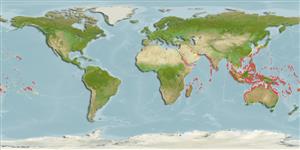Issue
Dascyllus abudafur<> former synonym of this species is resurrected with Indian Ocean distribution and D. aruanus restricted to Pacific Ocean. Information herein will be re-assigned accordingly.
Environment: milieu / climate zone / kisaran kedalaman / distribution range
Ekologi
laut berasosiasi dengan karang; nir-ruaya; kisaran kedalaman 0 - 20 m (Ref. 9710). Tropical; 38°N - 35°S, 19°E - 124°W
Pacific Ocean: region north and east of Lombok Strait to Line, Marquesan and Tuamoto islands, north to southern Japan, south to New Caledonia.
Length at first maturity / Size / Weight / umur
Kematangan: Lm 5.0 range ? - ? cm
Max length : 10.0 cm TL jantan/; (Ref. 4391); common length : 6.0 cm TL jantan/; (Ref. 5450); Umur maksimum dilaporkan: 6 Tahun (Ref. 72479)
deskripsi pendek
Kunci identifiaksi (pengenalan) | Morfologi | Morfometrik
Duri punggung (Keseluruhan (total)) : 12; duri punggung lunak (Keseluruhan (total)) : 11 - 13; Duri dubur: 2; Sirip dubur lunak: 11 - 13. Color in life white with 3 black bars; a large brown spot on dorsal part of snout and interorbital; lips dusky or white; caudal fin pale; pelvic fins black; pectorals transparent. Margins of preorbital, suborbital, and preoperculum finely serrated (Ref. 2746). Body depth 1.5-1.7 in SL (Ref. 90102).
Body shape (shape guide): short and / or deep; Cross section: compressed.
Territorial, inhabit shallow lagoon and subtidal reef flats. Form large aggregations above staghorn Acropora thickets or in smaller groups above isolated coral heads. Feed on zooplankton, benthic invertebrates, and algae. Males invite females to spawn in their nests; protecting the eggs until they hatch and becoming very aggressive against other fish. Eggs hatch after 3-5 days; pelagic larvae feed on plankton (Ref. 5503). Oviparous, distinct pairing during breeding (Ref. 205). Used in behavioral study. Have been reared in captivity (Ref. 35412). Diurnal species (Ref. 54980, 120737).
Male selects and protects the nest; does the courtship `dance' about 1 m above the nest and escorts the attracted female to the nest site where spawning ensues (Ref. 33146). Oviparous, distinct pairing during breeding (Ref. 205). Eggs are demersal and adhere to the substrate (Ref. 205). Also Ref. 103751.
Borsa, P., A. Sembiring, C. Fauvelot and W.-J. Chen, 2014. Resurrection of Indian Ocean humbug damselfish, Dascyllus abudafur (Forsskål) from synonymy with its Pacific Ocean sibling, Dascyllus aruanus (L.). Comptes Rendus Biologies, Elsevier Masson, 337(709-716). (Ref. 119133)
Status IUCN Red List (Ref. 130435: Version 2025-1)
ancaman kepada manusia
Harmless
penggunaan manusia
Perikanan: tidak ada kepentingan; Akuarium: Komersial
Alat, peralatan
laporan khas
muat turun XML
Sumber internet
Estimates based on models
Preferred temperature (Acuan
123201): 24.9 - 29.3, mean 28.4 °C (based on 2883 cells).
Phylogenetic diversity index (Acuan
82804): PD
50 = 0.5005 [Uniqueness, from 0.5 = low to 2.0 = high].
Bayesian length-weight: a=0.02239 (0.01738 - 0.02884), b=2.95 (2.88 - 3.02), in cm total length, based on LWR estimates for this species (Ref.
93245).
Trophic level (Acuan
69278): 3.3 ±0.42 se; based on food items.
Daya lenting (Acuan
120179): sedang, Waktu penggandaan populasi minimum 1.4 - 4.4 tahun (tmax=6; Fec=1,500-2,000).
Fishing Vulnerability (Ref.
59153): Low vulnerability (10 of 100).
🛈
Nutrients (Ref.
124155): Calcium = 110 [52, 178] mg/100g; Iron = 0.796 [0.461, 1.348] mg/100g; Protein = 18.2 [17.0, 19.3] %; Omega3 = 0.117 [0.065, 0.201] g/100g; Selenium = 19.4 [9.7, 40.5] μg/100g; VitaminA = 185 [52, 631] μg/100g; Zinc = 1.52 [0.99, 2.25] mg/100g (wet weight);
